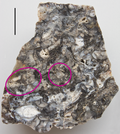Rhynie chert
Coordinates: 57°20′12″N 002°50′29″W / 57.33667°N 2.84139°W

The Rhynie chert is a Lower Devonian sedimentary rock, part of the Old Red Sandstone. It has extraordinary fossils, and is a Lagerstätte.
The chert is exposed near the village of Rhynie, Aberdeenshire, Scotland. A second unit, the Windyfield chert, is some 700 m away.
The Rhynie chert is exceptionally preserved material covered by an overlying volcanic deposit. Most of the fossil bed has primitive plants (which had water-conducting cells and sporangia, but no true leaves). There are also arthropods, lichens, algae and fungi.
Significance
Date
This fossil bed is remarkable for two reasons. First, the age of the site, formed about 410 million years ago.[1][2] This places it at an early stage in the colonisation of land. Second, the sheer quantity and variety of lifeforms throws a vivid light on the whole ecosystem near the hot springs.
Quantity
Seven land plant taxa have been found in the Rhynie and Windyfield cherts:[3]
- Aglaophyton
- Asteroxylon
- Horneophyton
- Nothia
- Rhynia
- Trichopherophyton
- Ventarura
Also, the cherts have crustacea, primitive insects and other arthropods, fungi, lichen, and cyanobacteria. Even mycorrhizas are found in the Rhynie chert.[4]
Quality
Second, these cherts are famous for their exceptional state of preservation. Individual cell walls are easy to see in polished specimens. Stomata have been counted and lignin remnants detected in the plant material. The "book lungs" of early spiders can be seen in cross-sections. Fungal hyphae can be seen entering plant material, acting as decomposers and mycorrhizal symbionts.
The oldest known insect (Rhyniognatha hirsti), which is rather like the modern springtails, was found in the Rhynie chert.[5] This pushes dates for the origin of insects back to the Silurian period.[6]
History of research
The chert was discovered by William Mackie while mapping the western margin of the Rhynie basin in 1910–1913.[7]
Since 1980, the chert has been examined by the Münster group, and from 1987 by Aberdeen University. They showed the chert was indeed produced by a hot spring setting.[7]
Conditions of formation
The chert was formed when silica-rich water from volcanic springs rose and rapidly petrified the early terrestrial ecosystem in situ. Organisms are petrified that way by hot springs today,[8] although that quality of preservation has not been found in recent deposits.[9] Hot springs, with temperatures between 90 to 120 °C (194 to 248 °F),[8] were active; the water had probably cooled to under 30 °C (86 °F) before it reached the fossilised organisms.[10][11] The deposits are interbedded with sands, shales and tuffs, which speaks of local volcanic activity.[12] Deposition was very rapid.[12][13]
The texture of the silica formed is like that found today in freshwater streams at Yellowstone National Park. They are typically alkaline (pH 8.7) and tepid 20 to 28 °C (68 to 82 °F).[9]
Living vegetation covered around 55% of the land area, with litter covering 30% and the remaining 15% of the ground being bare.[10][10][14]
Rhynie Chert Media
Other websites
- "Rhynie Chert Learning Resource". University of Aberdeen.
References
- ↑ Rice C.M.; et al. (1995). "A Devonian auriferous hot spring system, Rhynie, Scotland". Journal of the Geological Society, London. 152 (2): 229–250. Bibcode:1995JGSoc.152..229R. doi:10.1144/gsjgs.152.2.0229. S2CID 128977213.
- ↑ "Natural Environment Research Council" (PDF). Archived from the original (PDF) on 2008-12-17. Retrieved 2011-03-29.
- ↑ University of Aberdeen, The biota of early terrestrial ecosystems: the Rhynie Chert.
- ↑ Remy W, Taylor TN, Hass H, Kerp H (1994). "4 hundred million year old vesicular-arbuscular mycorrhizae". Proc. Natl. Acad. Sci. U.S.A. 91 (25): 11841–11843. Bibcode:1994PNAS...9111841R. doi:10.1073/pnas.91.25.11841. PMC 45331. PMID 11607500.
- ↑ Whalley, Paul; Jarzembowski, Ed (1981). "A new assessment of Rhyniella, the earliest known insect, from the Devonian of Rhynie, Scotland". Nature. 291 (5813): 317. Bibcode:1981Natur.291..317W. doi:10.1038/291317a0. S2CID 4339420.
- ↑ Engel, Michael S.; Grimaldi, DA (2004). "New light shed on the oldest insect". Nature. 427 (6975): 627–30. Bibcode:2004Natur.427..627E. doi:10.1038/nature02291. PMID 14961119. S2CID 4431205.
- ↑ 7.0 7.1 Trewin N.H. (2003). "History of research on the geology and palaeontology of the Rhynie area, Aberdeenshire, Scotland". Transactions of the Royal Society of Edinburgh Earth Sciences. 94 (4): 285–297. doi:10.1017/S0263593300000699. S2CID 128424299.
- ↑ 8.0 8.1 Trewin N.H. (2007). "The Rhynie Cherts: An Early Devonian Ecosystem Preserved by Hydrothermal Activity". Ciba Foundation Symposium 202 - Evolution of Hydrothermal Ecosystems on Earth (And Mars?). Ciba Found Symp. Novartis Foundation Symposia. Vol. 202. pp. 131–45. doi:10.1002/9780470514986.ch8. ISBN 9780470514986. PMID 9243014.
- ↑ 9.0 9.1 Trewin, Nigel H.; Fayers, Stephen R.; Kelman, Ruth (2003). "Subaqueous silicification of the contents of small ponds in an early Devonian hot-spring complex, Rhynie, Scotland". Canadian Journal of Earth Sciences. 40 (11): 1697–1712. Bibcode:2003CaJES..40.1697T. doi:10.1139/e03-065. Archived from the original on 2012-12-16. Retrieved 2008-05-15.
- ↑ 10.0 10.1 10.2 Trewin, Nigel H.; Wilson, Elizabeth (2004). "Correlation of the early Devonian Rhynie chert beds between three boreholes at Rhynie, Aberdeenshire". Scottish Journal of Geology. 40 (1): 73–81. doi:10.1144/sjg40010073. S2CID 128937466.
- ↑ Powell C.L.; Trewin, N. H.; Edwards, D. (2000). "Palaeoecology and plant succession in a borehole through the Rhynie cherts, Lower Old Red Sandstone, Scotland". Geological Society London Special Publications. 180 (1): 439–457. Bibcode:2000GSLSP.180..439P. doi:10.1144/GSL.SP.2000.180.01.23. S2CID 129847888.
- ↑ 12.0 12.1 Rice, C. M.; Trewin, N. H.; Anderson, L. I. (2002). "Geological setting of the early Devonian Rhynie cherts, Aberdeenshire, Scotland: an early terrestrial hot spring system" (abstract). Journal of Geological Society. 159 (2): 203–214. Bibcode:2002JGSoc.159..203R. doi:10.1144/0016-764900-181. S2CID 55042118. Retrieved 2008-05-15.
- ↑ Wellman, Charles H. (2006). "Spore assemblages from the Lower Devonian 'Lower Old Red Sandstone' deposits of the Rhynie outlier, Scotland". Transactions of the Royal Society of Edinburgh Earth Sciences. 97 (2): 167–211. doi:10.1017/S0263593300001449. S2CID 128754463.
- ↑ Fayers S.R.; Trewin, Nigel H. (2003). "A review of the palaeoenvironments and biota of the Windyfield chert". Transactions of the Royal Society of Edinburgh Earth Sciences. 94 (4): 325–339. doi:10.1017/S0263593300000729. S2CID 129845220.
- Contains useful reconstructions of both the plant associations, and the regional setting.








